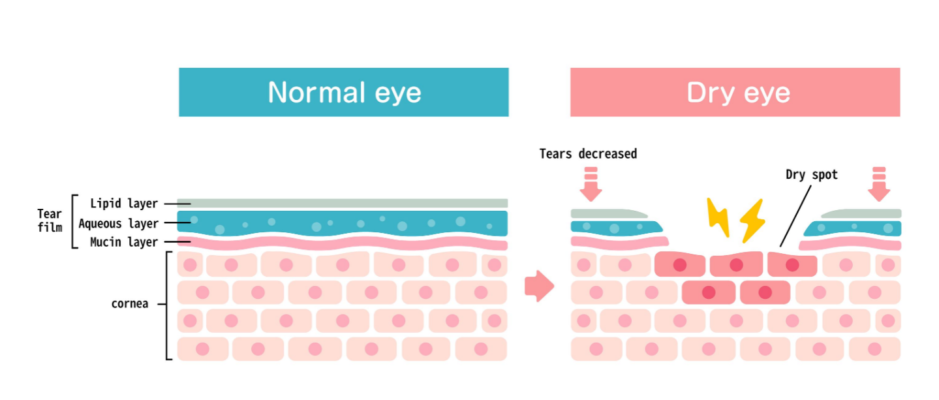When blinking, a film of tears spreads over the eye. This film is made up of an outer oily layer, middle watery layer, and innermost mucus layer that helps to maintain a healthy, clear eye. Each layer of the tear film is essential, and issues with any layer can negatively impact the production of tears. When there is a lack of lubrication to nourish the eye, dry eyes can occur. Dry eyes are a common, yet uncomfortable and potentially painful, condition brought upon by various factors outlined below.
Causes
Two main causes of dry eyes are decreased tear production and increased tear evaporation.
The causes of decreased tear production might include the following:
- Aging
- Certain health conditions (diabetes, lupus, ocular rosacea, Sjogren’s)
- Certain medications (blood pressure, antidepressants, antihistamines)
- Corneal nerve de-sensitivity caused by long-term contacts use or nerve damage
The causes of increased tear evaporation might include the following:
- Environmental conditions (smoke, wind, dry climates)
- Posterior blepharitis
- Eyelid problems like ectropion (lids turning outward) or entropion (lids turning inward)
- Eye allergies
If you are a frequent computer user, you are also likely to experience dry eyes as you tend to blink less when looking at a screen. Additionally, dry eyes tend to affect women more than men, as hormonal changes and fluctuations can affect the consistency of the production of tears.

Symptoms
Dry eye symptoms are fairly straightforward, but do vary in intensity. You might experience any combination of the following if you suffer from dry eyes:
- Stinging or burning
- Itching or grittiness
- Red or irritated eyes
- Blurred vision
- Strings of mucus in or around the eyes
- Pain when putting in contacts
Treatments
At your eye exam, your ophthalmologist will check to determine the severity of your dry eyes. They might do this by performing a Schirmer’s test to measure the volume of tears that your eye produces, or perform a tear film osmolarity test to determine the amount of solutes in the tear film. They might also perform a fluorescein dye test to determine if there are any microabrasions hindering the production of tears, or measure the time it takes for the tear film to break apart. In some instances, your ophthalmologist might recommend you get bloodwork done to rule out any underlying disorder.
Once the ophthalmologist determines whether or not you have dry eyes, they can discuss the next steps with you. This might include IPL treatments, prescription eyedrops, or other medications to either increase the production of tears or decrease tear evaporation. It goes without saying that dry eyes can be incredibly uncomfortable and difficult to deal with daily; our ophthalmologists are here to help. Call our office today at 954-741-5555 to schedule a consultation.






